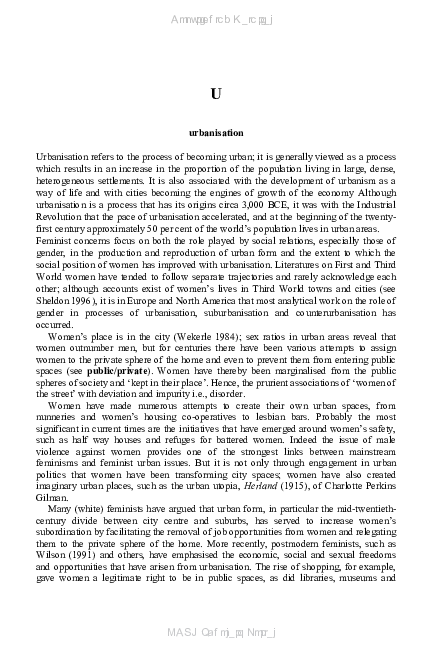Academia.edu no longer supports Internet Explorer.
To browse Academia.edu and the wider internet faster and more securely, please take a few seconds to upgrade your browser.
2000. "Urbanisation" and "Urban Planning" in L. Code (ed.) Encyclopaedia of Feminist Theories (London: Routledge), pp.479-80.
2000. "Urbanisation" and "Urban Planning" in L. Code (ed.) Encyclopaedia of Feminist Theories (London: Routledge), pp.479-80.
2000. "Urbanisation" and "Urban Planning" in L. Code (ed.) Encyclopaedia of Feminist Theories (London: Routledge), pp.479-80.
2000. "Urbanisation" and "Urban Planning" in L. Code (ed.) Encyclopaedia of Feminist Theories (London: Routledge), pp.479-80.
2000. "Urbanisation" and "Urban Planning" in L. Code (ed.) Encyclopaedia of Feminist Theories (London: Routledge), pp.479-80.
2000, Encyclopaedia of Feminist Theories
Related Papers
Political Geography
1990. Kofman, E. and Peake, L. "Into the 1990s: A Gendered Agenda for Political Geography". Political Geography Quarterly.1990 •
This paper introduces the intertwining of resistance and reimagining through a utopian method of thinking differently about alternative urban futures. The case is made for recognising gender studies of the built environment and feminist pedagogy as a 'place to think with'. The paper introduces a well-rehearsed critique of the sexist city before considering the nature of transformation as a creative process, beyond the usual political spaces of opposition. A 'hopeful' power of transformation is illustrated in two interdependent scales of action represented in niche demonstrations of intentional egalitarian community, and feminist teaching and learning. The paper concludes with a suggested agenda for continuing research at the interface of cities, gender and transformation.
This article juxtaposes insights from recent urban policy mobilities scholarship on circulating knowledges with an in-depth examination of a long-standing (1976-2013) amalgam of groups and individuals whose focus is safer cities for women and girls. The article addresses three gaps. One, it is an empirical study that draws on in-depth knowledge of its authors to shed light on gender informed efforts to shift circulating knowledges relevant to policies to advance gender equality goals in cities. Two, it examines this terrain with a focus on a variety of actors who are not typically acknowledged as 'policy-makers'. Three, it provides new insights about the " connective tissue " of policy-making and in particular, the potential power of a methodological approach that recognizes the benefits of linking together women as 'experts in their own lives' with professionals who have 'a taste for justice'. The paper does so by highlighting three
Environment and Planning D
1993. "Race and sexuality: challenging the patriarchal structuring of urban social space". Environment and Planning D: Society and Space.1993 •
This article explores safety and politics of space in two ways. First, it reviews research on women’s fear and calls for safer cities, identifying four contradictions in the geography of fear discourse. Second, it elaborates on how including various forms of fear may repoliticize the contemporary depoliticized and co-opted safety discussion by focusing on sexist and racist threats rather than exclusively on the white middle classes. Here, threats to veiled Muslim women and their experiences in public spaces are, in particular, emphasized as exemplifying fears that are neglected in the safety debate. The article concludes that, rather than the whole safety issue being dismissed as ‘neoliberal’, there is an urgent need to strengthen the analysis of power and illuminate experiences of pain and fear in sexist and racist violence.
Canadian Geographer / Le Géographe canadien
Refractions and recombinations of the ‘economic’ and the ‘social’: a personalized reflection on challenges by-and to-feminist urban geographies2010 •
Gender, Place & Culture
Constructing gender, constructing the urban: A review of Anglo-American feminist urban geography2003 •
RELATED PAPERS
The SAGE handbook of social geographies
2009. "Gender, race, sexuality" in Smith, S., Pain, R., Marston, S. and Jones III, J. P. (eds.) The Handbook of Social Geography (London: SAGE), pp.129-195.2009 •
1984 •
1994 •
Political Geography Quarterly
‘Collective consumption’ revisited: Analysing modes of provision and access to childcare services in Montréal, Quebec1990 •
Urban Studies
Planning responds to gender violence: Evidence from Spain, Mexico and the United States2010 •
2009 •
2015 •
IDS Bulletin
Women-Headed Households: Poorest of the Poor?: Perspectives from Mexico, Costa Rica and the Philippines1997 •
Geography Research Forum (Vol 39, number 1)
Queer Urban Movements from the Margin(S): Activism, Politics, Space2019 •
Gender, Place & Culture
Gender, Ethnicity, and Hybrid Forms of Community-Based Urban Activism in Vancouver, 1957-1978: The Strathcona story revisited2007 •
Geography Research Forum • Vol. 39 • 2019: 90-105.
Being Queer Feminists in Delhi: Narratives of (Non) Belonging2019 •
XXXIII IAHS World Congress on Housing
Gender and gender sensitivity in the South African housing policy: preliminary evidence from Mangaung (Bloemfontein)2005 •
Transactions of The Institute of British Geographers
Doing gender and development: understanding empowerment and local gender relations2003 •
Social Theory & Health
Utopian Theory and the Discourse of Natural Birth2006 •
IDS bulletin
Women‐Headed Households: Poorest of the Poor?: Perspectives from Mexico, Costa Rica and the Philippines11997 •
Signs Journal of Women in Culture and Society
Women in the Urban Environment1980 •
- Find new research papers in:
- Physics
- Chemistry
- Biology
- Health Sciences
- Ecology
- Earth Sciences
- Cognitive Science
- Mathematics
- Computer Science

 Linda J Peake
Linda J Peake